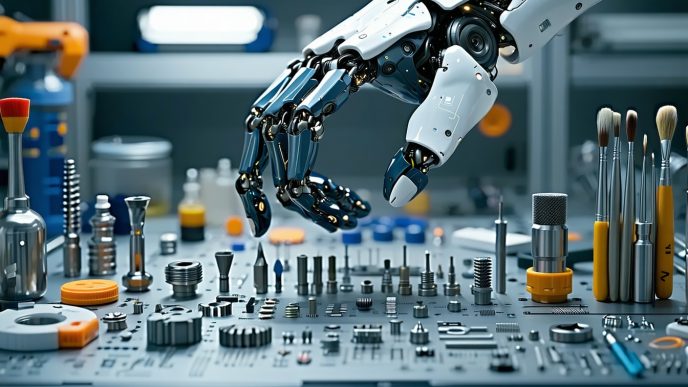Introduction to Gripping & Manipulation in Robotics
Robots play a significant role in various applications, requiring precise gripping and manipulation capabilities. The effectiveness of a robot often lies in its ability to adapt its grip depending on the object’s characteristics. Understanding the intricacies of adaptive gripping in robots is essential for advancing robotic technology and enhancing interactions with diverse objects.
The Importance of Adaptive Gripping
Adaptive gripping involves the ability of robots to adjust their grip based on factors such as object shape, weight, and fragility. As robots increasingly perform tasks that require dexterity, the importance of adaptive gripping technology cannot be overstated. Effective gripping techniques enable robots to handle fragile items without causing damage and to securely grasp heavy objects without dropping them. The following table summarizes key aspects of adaptive gripping:
| Key Aspect | Description |
|---|---|
| Flexibility | Ability to grip various objects of different shapes and weights |
| Safety | Ensures fragile items are handled gently |
| Efficiency | Reduces errors during manipulation tasks |
| Versatility | Allows robots to operate in diverse environments |
For more information on how robots grip and manipulate objects, refer to our article on robot gripping and manipulation.
Overview of How Robots Interact with Objects
The interaction between robots and objects is multifaceted, involving sensors, algorithms, and mechanical designs. Robots utilize a combination of tactile sensors and visual systems to perceive their environment, enabling them to identify and assess objects before gripping them. These sensors contribute to the robot’s understanding of the texture, weight, and size of an object, which in turn influences gripping strategy.
A variety of manipulation tasks can include lifting, rotating, or placing objects, each requiring specific grip adjustments. The efficiency of these processes relies on the integration of robot grasping technology and tactile sensors in robot hands. The following table outlines the main components involved in robotic interactions with objects:
| Component | Function |
|---|---|
| Sensors | Gather data about object characteristics |
| Algorithms | Process sensor data to determine grip strategies |
| Actuators | Execute the gripping action |
| Control Systems | Coordinate movements and adjustments |
This complex interplay allows robots to perform robot manipulation tasks effectively, paving the way for advancements in automation and robotic applications. Understanding these interactions enhances knowledge of the future of robotic manipulation, driving further innovation in the field.
Understanding Adaptive Gripping
Definition and Purpose
Adaptive gripping in robots refers to the ability of robotic systems to modify their gripping techniques based on the characteristics of objects they interact with. The primary purpose of this technology is to enhance the efficiency and accuracy of manipulation tasks by allowing robots to accommodate various shapes, weights, and fragilities of objects. By doing so, robots can handle items more safely and effectively, whether in industrial settings or domestic environments.
The adaptability in gripping is crucial for performing tasks requiring different levels of dexterity. For example, a robot designed to pick up fragile glassware must adjust its grip compared to a robot handling sturdy metal components. The flexibility in gripping techniques ensures the safety and reliability of operations.
| Feature | Importance |
|---|---|
| Object Shape | Determines how a robot grasps and holds. |
| Object Weight | Influences grip strength and stability. |
| Object Fragility | Affects the pressure applied during gripping. |
Adaptive Gripping Technology
Adaptive gripping technology encompasses various tools and methods that enable robots to adjust their grip dynamically. These technologies include advanced sensors, machine learning algorithms, and feedback systems.
- Sensor-Based Systems:
Robots use sensors to gather information about objects, including their shape, texture, and weight. Tactile sensors in robot hands, for instance, provide real-time data on the object’s surface and help the robot fine-tune its grip. - Machine Learning Algorithms:
These algorithms analyze data from previous gripping tasks to improve grip adjustments over time. By learning from past experiences, robots can better predict the optimal grip strategy for new objects. - Feedback Loops:
Feedback systems enable robots to reassess their grip based on continuous sensory input. If a robot feels that an object is slipping, it can modify its grip strength dynamically to ensure secure handling.
The implementation of these technologies significantly enhances a robot’s gripping capabilities. For a deeper understanding of how these components work together, refer to our article on robot grasping technology.
Adaptive gripping is essential in a variety of applications, from manufacturing to personal robotics. By utilizing a combination of advanced technology and adaptive techniques, robots can efficiently perform complex manipulation tasks while maintaining object integrity and safety. For more information on the applications of gripping technologies, visit our section on robot manipulation tasks.
Factors Influencing Grip Adjustment
Adaptive gripping in robots is influenced by multiple factors that determine how effectively they can grasp and manipulate various objects. Understanding these elements is crucial for optimizing robotic performance in diverse applications.
Object Shape
The shape of an object plays a significant role in how a robot adjusts its grip. Robots need to analyze the contours, dimensions, and geometry of the object to select the appropriate gripping method. Irregularly shaped items require more sophisticated adaptive techniques to ensure a secure hold, while regular shapes like cylinders or cubes are easier to grasp.
| Object Shape Type | Gripping Technique Adaptation |
|---|---|
| Cylindrical | Pinch Grip |
| Cubic | Palmar Grip |
| Irregular | Precision Grip |
| Flat | Suction Grip |
Robots equipped with advanced gripping systems can change their grip based on the object’s outline, as outlined in the article about robot gripping and manipulation.
Object Weight
The weight of an object is another crucial factor influencing grip adjustment. Heavier objects often require a firmer grip without compromising the robot’s ability to manipulate them successfully. Algorithms can help robots determine the necessary gripping strength based on the object’s weight, ensuring that they do not drop or crush the item.
| Weight Category | Recommended Gripping Strength (N) |
|---|---|
| Light (< 1 kg) | 5 – 10 N |
| Medium (1 – 5 kg) | 10 – 20 N |
| Heavy (> 5 kg) | 20 – 50 N |
Adaptive grip strength can be achieved by analyzing the weight through sensors. For more details on gripping strength, refer to our article on gripping strength in robots.
Object Fragility
Fragility is another consideration when robots adjust their grip. Delicate items require a lighter and more controlled grip to prevent damage. Robots featuring tactile sensors can gauge the texture and sensitivity of an object, allowing for appropriate adjustments in grip strength.
| Fragility Level | Grip Adjustment Style |
|---|---|
| Fragile | Gentle Grip |
| Moderate | Balanced Grip |
| Durable | Firm Grip |
By implementing technology such as tactile sensors, robots can improve their ability to handle fragile items, as described in our article on tactile sensors in robot hands.
Understanding these factors is essential for enhancing adaptive gripping in robots, enabling them to perform complex robot manipulation tasks more efficiently and accurately in various environments.
Techniques for Adaptive Gripping
Adaptive gripping in robots relies on various techniques that enable them to adjust their grip based on the characteristics of the objects they are interacting with. These methods include sensor-based grip adjustment, machine learning algorithms, and feedback loops in gripping. Each technique plays a crucial role in enhancing the dexterity and efficiency of robotic systems.
Sensor-Based Grip Adjustment
Sensor-based grip adjustment involves the use of different types of sensors to gather real-time data about the object being handled. Common sensors include tactile sensors, pressure sensors, and vision sensors. These sensors help the robot to assess important characteristics of the objects, such as shape, weight, and surface texture.
| Sensor Type | Function | Key Benefits |
|---|---|---|
| Tactile Sensors | Detects contact and pressure | Provides feedback for grip adjustment |
| Pressure Sensors | Measures the force applied during grip | Prevents damage to fragile objects |
| Vision Sensors | Analyzes shape and orientation | Enables precise manipulation |
Sensor data allows robots to adjust their grip strength and approach dynamically, ensuring optimal contact with the object while minimizing the risk of slippage or breakage. For more information on how tactile sensors enhance robot functioning, refer to our article on tactile sensors in robot hands.
Machine Learning Algorithms
Machine learning algorithms enable robots to learn from experience and improve their grabbing techniques over time. By analyzing data from past interactions and simulations, robots can refine their gripping strategies for improved performance. These algorithms support various tasks such as identifying the optimal grasp configuration or adapting to unexpected changes in object characteristics.
With the aid of machine learning, robots can:
- Recognize patterns in object shapes and weights.
- Predict the best gripping method for different tasks.
- Adjust grip strategies based on prior successes or failures.
The integration of machine learning in robotic systems enhances their adaptability and efficiency in manipulating objects. For further insights into robot manipulation tasks, explore our article on robot manipulation tasks.
Feedback Loops in Gripping
Feedback loops are essential for fine-tuning grip adjustments during the manipulation process. These loops allow robots to continuously monitor their grip and make real-time modifications based on feedback received from sensors. When a robot grips an object, it senses the pressure exerted and can adjust the grip strength accordingly.
Key features of feedback loops in gripping include:
- Continuous monitoring of grip pressure.
- Immediate adjustments based on tactile or pressure sensor input.
- Enhanced coordination in multi-fingered robotic hands.
This process ensures maximum efficiency and safety while handling a variety of objects. For information on the gripping strength utilized by robots, see our article on gripping strength in robots.
By employing these techniques, robots can effectively adapt their gripping mechanisms to accommodate diverse objects, enhancing their ability to perform complex tasks. These advancements significantly contribute to the field of robotics, paving the way for more sophisticated and capable automated systems.
Applications of Adaptive Gripping
Adaptive gripping technology plays a crucial role in various fields. Robots equipped with such technology can perform complex tasks by adjusting their grip to suit different objects. Here are some key areas where adaptive gripping is particularly beneficial.
Industrial Automation
In industrial settings, robots are often tasked with handling a variety of components and materials. Adaptive gripping allows these robots to manipulate items ranging from fragile electronic parts to heavy machinery components. By utilizing sensors and advanced algorithms, these robots can efficiently adjust their grip based on the size and shape of the objects they are handling.
| Application | Object Type | Grip Adjustment Feature |
|---|---|---|
| Assembly Lines | Small electronic parts | Fine grip adjustment to prevent damage |
| Material Handling | Heavy metal sheets | Strong grip safety to secure weight |
| Quality Control | Fragile items | Gentle touch sensors for inspection |
The ability to adapt their gripping strategies ensures that robots can operate efficiently in tasks such as assembly, quality control, and packaging.
Warehouse Robotics
Warehouse environments often involve moving a diverse array of products, including boxes, pallets, and delicate items. Robots equipped with adaptive gripping capabilities can optimize the way they handle these items. For instance, a robot may use a robust grip for heavy packages while employing a softer touch for lightweight or fragile goods.
| Task | Item Type | Gripping Technology |
|---|---|---|
| Picking Operations | Cartons and boxes | Pressure-sensitive grip adjustments |
| Sorting Systems | Small packages | Dynamic shape recognition and grip |
| Inventory Management | Various item sizes | Versatile gripping techniques |
This flexibility leads to improved efficiency in tasks such as sorting, picking, and inventory management, allowing for smoother workflows in warehouses.
Assistive Robots for Elderly or Disabled
Assistive robots designed for elderly or disabled individuals benefit greatly from adaptive gripping technology. These robots must navigate the delicate task of assisting users without causing any harm. For example, a robot may need to help with daily activities such as grasping utensils, handling medications, or lifting light objects.
| Application | Task | Grip Feature |
|---|---|---|
| Daily Living Assistance | Helping with food | Gentle grasp for utensils |
| Medication Dispensing | Handling pill bottles | Secure grip without crushing |
| Mobility Assistance | Supporting users | Adjustable grip for varied support |
By utilizing adaptive gripping, assistive robots enhance their ability to interact safely and effectively with users, significantly improving their quality of life.
Adaptive gripping in robots not only enhances their functional capabilities but also helps bridge the gap between technology and human interaction. This innovative technology is paving the way for advancements in robot gripping and manipulation, enabling robots to perform increasingly complex robot manipulation tasks in various applications.
Challenges in Adaptive Gripping
The field of robotics constantly evolves, particularly in gripping and manipulation. As robots become more sophisticated, they encounter challenges that arise from the complexity of objects and the need for real-time decision-making.
Complex Objects
Complex objects present a significant hurdle for adaptive gripping in robots. These objects can vary in shape, size, and materials, leading to the need for highly versatile gripping technology. Irregular and asymmetrical shapes can make it difficult for robots to securely hold or manipulate items without dropping or damaging them.
| Object Type | Characteristics | Gripping Challenges |
|---|---|---|
| Soft Fruits | Fragile, elastic | Risk of crushing |
| Irregular Tools | Non-symmetrical, sharp edges | Difficulty in securing grip |
| Delicate Glassware | Fragile, lightweight | High risk of breakage |
To address these challenges, robots require advanced sensory feedback mechanisms, such as tactile sensors in robot hands. These sensors allow robots to detect the properties of objects, enabling them to adjust their grip strength accordingly.
Real-Time Decision Making
Real-time decision-making is crucial for adaptive gripping. Robots must analyze their surroundings rapidly and make adjustments on-the-fly. Factors such as unexpected movement, shifting weight, or changes in object shape can necessitate rapid responses from the robotic system.
Effective algorithms are required to process data from sensors and control systems promptly. Machine learning techniques can aid in improving these decision-making processes by allowing robots to learn from previous experiences and adjust their gripping techniques accordingly.
| Decision Factors | Examples | Impact on Gripping |
|---|---|---|
| Object Movement | A person accidentally bumps into a table | Grip must adapt to prevent dropping |
| Weight Distribution | An unevenly loaded box | Robot needs to adjust grip position |
Enhancing robotics for real-time responsiveness involves integrating various technologies and is a key focus of ongoing research. For further insights into the advancements in robotics, explore the article on robot manipulation tasks for examples of how robots engage with their environments effectively.
The challenges of handling complex objects and real-time decision-making highlight the ongoing need for innovation in robot gripping and manipulation to create more capable and efficient robots.
Future Developments in Gripping Technology
The field of robotics is evolving rapidly, and the advancements in gripping technology are transforming how robots physically interact with objects. Significant developments are expected in several areas, including enhanced sensory systems, the integration of AI, and ethical considerations in adaptive gripping.
Enhanced Sensory Systems
The future of adaptive gripping in robots will heavily rely on improved sensory technologies. Enhanced sensory systems will provide robots with better feedback about the objects they are manipulating. This includes the use of advanced tactile sensors that can detect pressure, texture, and temperature. These sensors will allow robots to adjust their grip dynamically based on real-time assessments of the object’s characteristics.
| Sensor Type | Functionality | Potential Benefits |
|---|---|---|
| Tactile Sensors | Measure pressure and surface texture | Improve grip firmness and adjust based on object complexity |
| Proximity Sensors | Detect distance to objects | Enable better spatial awareness for manipulation tasks |
| Thermal Sensors | Detect temperature changes | Assist in handling fragile or heat-sensitive items |
Utilizing such technologies can lead to more refined interactions during robot manipulation tasks.
Integration of AI and Robotics
Artificial intelligence (AI) will play a pivotal role in enhancing adaptive gripping technologies. By integrating AI with robotic systems, robots can learn from their interactions with various objects. Machine learning algorithms can help robots analyze prior grip attempts to improve future performance, optimizing the grip based on historical data and predictive models.
Robots equipped with AI frameworks can develop capabilities that allow them to make decisions on-the-fly. For example, they can choose the best grip method based on object shape and fragility using data from past experiences. This integration is vital for developing more effective robot grasping technology.
Ethical Considerations in Adaptive Gripping
As robots become more integrated into everyday life, ethical considerations surrounding adaptive gripping technology will emerge as a critical topic. As robots gain enhanced dexterity and the ability to manipulate fragile objects—such as medications for the elderly—they must operate with a high level of reliability and safety. Issues concerning user data privacy, job displacement, and the potential misuse of robotic capabilities must be addressed.
Developers and researchers will need to establish guidelines and frameworks to ensure that these advancements are implemented ethically. As the field progresses, stakeholders will be tasked with balancing innovative technology with responsibility to enhance human-robot interactions without compromising safety.
In conclusion, the future of gripping technology in robotics holds exciting possibilities. Continued advancements in sensory systems, combined with AI integration, will enable robots to adapt their gripping techniques intelligently. As these technologies evolve, addressing ethical considerations will be essential to ensure beneficial outcomes for society. For more insights into robot capabilities, explore our articles on robot gripping and manipulation and future of robotic manipulation.















